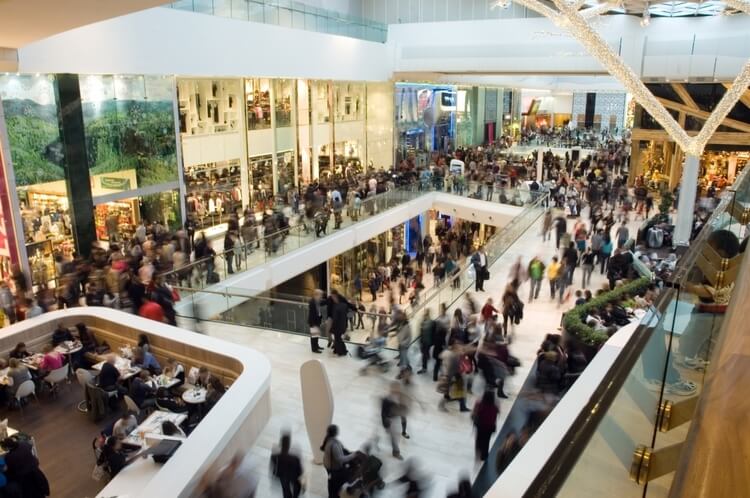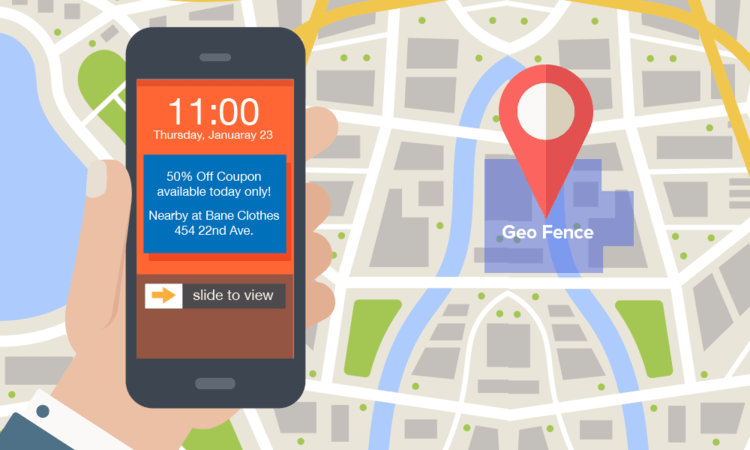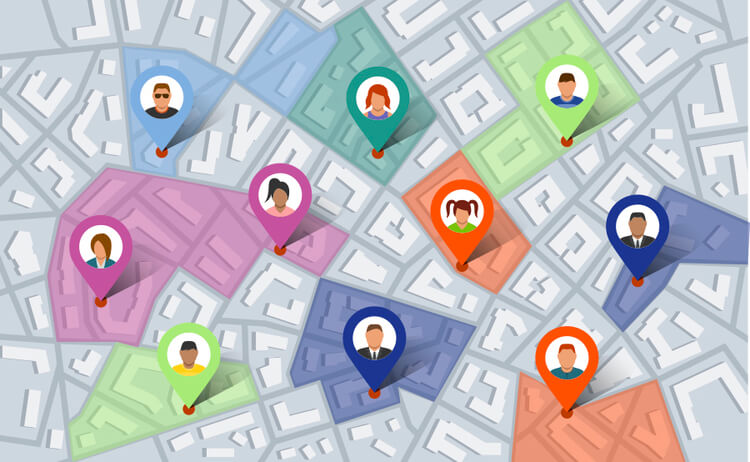Geofencing marketing is a powerful way for businesses to engage their mobile users. And with this year’s sales set to be one of the biggest ever, retailers will want to take their campaigns to the next level for 2023.
These tips will give you a better understanding of what geofencing marketing is and how you can use it to improve user experience, drive customers to your stores and boost your sales this year.

What is geofencing marketing?
Also known as location-based marketing, geofencing marketing makes it possible for businesses to send geo targeted ads to their app users within a specific geographic area. The process involves setting up virtual boundaries (geofences) around a real-world location such as a shop or other point of interest. As app users enter the geofence they’re sent location-based push notifications or ads on their mobile devices.
How does geofencing marketing work?
This type of marketing is very useful when businesses want to attract more customers to their premises, or to engage crowds at special events or festivals. Businesses can also set up geofences around their competitors to lure their customers away – this is what is known as geo-conquesting. Importantly, geofencing lets brands gather insights about their app users, enabling them to market to them in a more relevant and personalized way.

The best geofencing marketing strategies to boost sales in 2023
Competition is going to be fierce in this year’s sales. Stay ahead of the game with our top tips to help you boost your profits to record levels.
Start early
It’s likely that you’re already planning on boosting sales through location-based deals and alerts. However, you might want to start early. By setting up your geofencing marketing campaigns in advance of the big day, you allow shoppers to plan their purchases beforehand. By starting early and using things like limited-time offers, you can uplift sales now instead of waiting for the rush.
Set up interest-based audiences
It’s pointless building geofencing marketing campaigns without first knowing who you’re building them for. A whopping 90% of consumers still shop in-store, offering marketers an opportunity to gather valuable insights that can improve customer experience and enrich audience targeting.
By using a geofencing platform like PlotProjects, you can access a wealth of user demographics and set up interest-based audiences which will improve your campaigns and boost your engagement rates. Whether they’re frequent runners in the market for new sportswear, car buyers visiting showrooms or regular customers visiting your competitors, it’s about giving shoppers the deals they actually want in the sales.
Geofence your competitors
Use your geofencing campaigns to gain a competitive advantage. By setting up geofences around your competitors, you can get insights about what consumers were interested in when in their stores, then offer a better deal. You can also configure your audience segments based on things like competitor locations and how often users are visiting. Once your geofences are secured, you can start enticing those customers away.
Create listening campaigns
Listening campaigns are another way of collecting valuable user insights – but without sending notifications. These are great for measuring footfall at yours or your competitor’s locations. With the PlotProjects technology, you can run a listening campaign on just one geofence, or thousands. The same applies to beacons. Listening campaigns are a hugely valuable tool to help you ensure you meet and exceed your sales forecasts.
Reach out at the perfect moment
The Plot plugin offers other valuable features that will help you supercharge your conversions by reaching out to users at the right moment. After all, 26% of marketing falls flat when you try to engage with consumers at the wrong time. With tools like home and work targeting, you can identify the moments when customers actually have the time for you, like when they’ve been home for a few hours, or when they’re heading out on their lunch break.
Consider the size of your geofences
Bigger isn’t always better when it comes to setting up geofences. If your geofence has a huge radius, you might be wasting your efforts on targeting users who are too far away to visit your store. It’s a good idea to plan your geofences carefully and make use of several smaller geofences that are within easy walking or driving distance. You might also want to complement your campaigns with polygon-shaped geofences and bluetooth beacons.
Serve the right content at the right time
It might sound pretty obvious but you should focus your geofencing marketing efforts on serving consumers with the right content exactly when it’s needed. According to Google, 67% of smartphone users switch to another app if it takes too many steps to purchase or get the desired information.
One way to avoid this is with the Plot Projects ‘Contextual Pages’ feature. It helps apps deliver relevant content at the right time, remove unnecessary steps and increase conversions. What’s more, it doesn’t rely on notifications, so apps can serve the users who opt-out of push messages.
Launch actionable ads
Your geofencing marketing campaigns are likely to get way more engagement if you launch actionable ads and a compelling call to action. Highlight in-store deals and rewards, target your existing audience with reasons to come in, and include personalized notifications. Try to avoid anything spammy. Top it off with a direct call to action like ‘learn more’, ‘shop now’ or ‘click here’.
Power your existing marketing with location insights
Powering your existing marketing channels – ads, emails and push – with location context will help you seize valuable real-time opportunities. With the Plot Platform you can create easy and flexible connections from your app to any customer data, geofencing marketing automation or analytics platforms, and boost conversions.

Modify your campaigns on the go
With geofencing marketing you can modify your campaigns on the go. If users aren’t responding as you expected, you can figure out what’s not working in your campaigns. For instance, you could be targeting users at the wrong time of day or in the wrong area. Keep a close eye on your data and analytics, and modify your campaigns where necessary.
Use a variety of targeting techniques
Context targeting, content targeting, home and work targeting, retargeting and more – with geofencing marketing you can use a variety of marketing techniques. By using multiple targeting options you communicate with your users more effectively and maximise your opportunities for conversions.
Refine future geofencing marketing efforts
By using these geofencing marketing strategies it’s likely you’ll be closing the deal and supercharging your sales. And even where a geofence doesn’t prompt an immediate sale, it provides you with valuable insights about exactly what location a consumer passed through.
You’ll know more about your customers, what offers interested them the most, what they bought from your competitors, and so on. Armed with this knowledge you can refine and perfect your future geofencing marketing efforts.
What brands use geofencing marketing?
In need of some inspiration? Here are just a few examples of the many businesses that use geofencing marketing, including best-use cases from big brands like Uber, Burger King and Vouchercloud. Take a look at these examples, or read our full guide here.
- Starbucks: Starbucks is well known for using creative geofencing campaigns to encourage walk-in sales. For example, when users are nearby during happy hour, they get personalized notifications reminding them of the deal.

- Uber: A clever example of geofencing marketing can be seen with Uber’s LAX campaign. Geofencing the airport made it possible for the company to bypass the ban on taxis and send users notifications about available cars nearby.
- Vouchercloud: One of the first brands to adopt geofencing, the company has used it to transform high street deals by delivering highly-targeted push notifications to customers close to participating retailers.
- Burger King: One of the most famous geofencing marketing campaigns is Burger King’s Whopper Detour. The burger giant geofenced thousands of McDonald’s restaurants then lured customers away by offering them a 1 cent Whopper burger.
Need help with your geofencing marketing strategy?
Geofencing marketing is a powerful and cost-effective way to drive sales for businesses both big and small. If you need help getting started with geofencing or you want to find out more about how our platform can drive results for your business, contact PlotProjects today.
You can try our demo app for free, or download one of our customer’s apps to see how it works. Don’t have an app? No problem. We can create a custom geofencing app using the PlotProjects technology.
